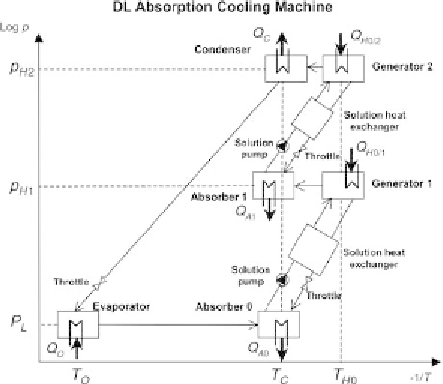Environmental Engineering Reference
In-Depth Information
Figure 5.4
Double lift absorption cooling cycle
of water/lithium bromide, as well as single effect (SE) and double lift (DL) ACMs
(Figure 5.4) with the working pair of ammonia/water.
The single effect/double lift (SE/DL) cycle with the working pair of water/lithium
bromide is a novel technique. Further cycle designs such as triple effect (TE) ACMs,
other multi-stage cycles and the use of the described cycles for solar cooling have
been investigated by a number of researchers (Kimura, 1992; Lamp and Ziegler, 1997;
Hoper, 1999; Ziegler, 1999).
Water/Lithium Bromide Properties
The advantages of water/lithium bromide are that water as refrigerant has a very high
specific evaporation enthalpy of 2489 kJ kg
−
1
(at +5
◦
C) and that the lithium bromide
solution is not volatile. The working pair itself is odourless and neither toxic nor
flammable. The disadvantages are the high freezing point of water and that lithium
bromide is not totally soluble inwater because of crystallization.Moreover, the vacuum
for the machines has to be very tight. Due to the high specific volume of water vapour
as refrigerant, the machines are not very compact.
The water/lithium bromide ACMs are usually water cooled by wet cooling towers
to avoid the possibility of crystallization of the lithium bromide solvent. As water is
used as refrigerant, the external evaporator temperature is restricted to temperatures
above the freezing point of at least
5
◦
C. Therefore the possible temperature range
of such machines is limited to pure air-conditioning and cold water generation.
+

Search WWH ::

Custom Search